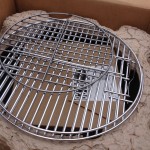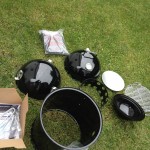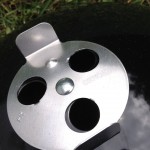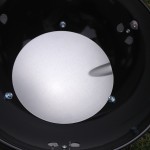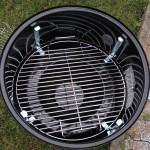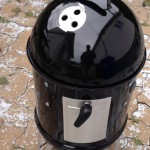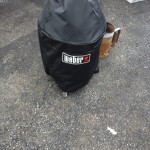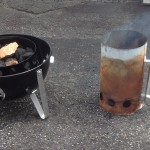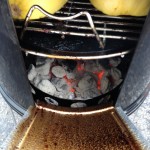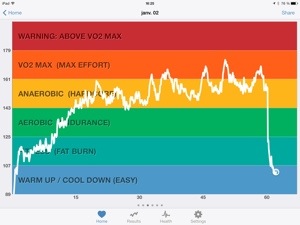Did my inaugural cook in the 14.5″ Weber Smokey Mountain my lifepartner is giving me for my birthday (she knows I don’t like surprises).
Will probably post some written notes of my smoking endeavours, at some point. In the meantime, some pictures documenting the whole thing.
Category Archives: geek culture
Body and Tech: My Year in Quantified Self
Though I’m a qual, I started quantifying my self a year ago.
Not Even Started Yet
This post is long. You’ve been warned.
This post is about my experience with the Quantified Self (QuantSelf). As such, it may sound quite enthusiastic, as my perspective on my own selfquantification is optimistic. I do have several issues with the Quantified Self notion generally and with the technology associated with selfquantification. Those issues will have to wait until a future blogpost.
While I realize QuantSelf is broader than fitness/wellness/health tracking, my own selfquantification experience focuses on working with my body to improve my health. My future posts on the Quantified Self would probably address the rest more specifically.
You might notice that I frequently link to the DC Rainmaker site, which is a remarkably invaluable source of information and insight about a number of things related to fitness and fitness technology. Honestly, I don’t know how this guy does it. He’s a one-man shop for everything related to sports and fitness gadgets.
Though many QuantSelf devices are already available on the market, very few of them are available in Quebec. On occasion, I think about getting one shipped to someone I know in the US and then manage to pick it up in person, get a friend to bring it to Montreal, or get it reshipped. If there were such a thing as the ideal QuantSelf device, for me, I might do so.
(The title of this post refers to the song Body and Soul, and I perceive something of a broader shift in the mind/body dualism, even leading to post- and transhumanism. But this post is more about my own self.)
Quaint Quant
I can be quite skeptical of quantitative data. Not that quants aren’t adept at telling us very convincing things. But numbers tend to hide many issues, when used improperly. People who are well-versed in quantitative analysis can do fascinating things, leading to genuine insight. But many other people use numbers as a way to “prove” diverse things, sometimes remaining oblivious to methodological and epistemological issues with quantification.
Still, I have been accumulating fairly large amounts of quantitative data about my self. Especially about somatic dimensions of my self.
Started with this a while ago, but it’s really in January 2013 that my Quantified Self ways took prominence in my life.
Start Counting
It all started with the Wahoo Fitness fisica key and soft heartrate strap. Bought those years ago (April 2011), after thinking about it for months (December 2010).
Had tried different exercise/workout/fitness regimens over the years, but kept getting worried about possible negative effects. For instance, some of the exercises I’d try in a gym would quickly send my heart racing to the top of my healthy range. Though, in the past, I had been in a more decent shape than people might have surmised, I was in bad enough shape at that point that it was better for me to exercise caution while exercising.
At least, that’s the summary of what happened which might make sense to a number of people. Though I was severely overweight for most of my life, I had long periods of time during which I was able to run up long flights of stairs without getting out of breath. This has changed in the past several years, along with other health issues. The other health issues are much more draining and they may not be related to weight, but weight is the part on which people tend to focus, because it’s so visible. For instance, doctors who meet me for a few minutes, only once, will spend more time talking about weight than a legitimate health concern I have. It’s easy for me to lose weight, but I wanted to do it in the best possible way. Cavalier attitudes are discouraging.
Habits, Old and New
Something I like about my (in this case not-so-sorry) self is that I can effortlessly train myself into new habits. I’m exactly the opposite of someone who’d get hooked on almost anything. I never smoked or took drugs, so I’ve never had to kick one of those trickiest of habits. But I often stop drinking coffee or alcohol with no issue whatsoever. Case in point: I’m fairly well-known as a coffee geek yet I drank less than two full cups of coffee during the last two months.
Getting new habits is as easy for me as kicking new ones. Not that it’s perfect, of course. I occasionally forget to bring down the lid on the toilet seat. But if I put my mind to something, I can usually undertake it. Willpower, intrinsic motivation, and selfdiscipline are among my strengths.
My health is a significant part of this. What I started a year ago is an exercise and fitness habit that I’ve been able to maintain and might keep up for a while, if I decide to do so.
Part of it is a Pilates-infused yoga habit that I brought to my life last January and which became a daily routine in February or March. As is the case with other things in my life, I was able to add this routine to my life after getting encouragement from experts. In this case, yoga and Pilates instructors. Though it may be less impressive than other things I’ve done, this routine has clearly had a tremendous impact on my life.
Spoiler alert: I also took on a workout schedule with an exercise bike. Biked 2015 miles between January 16, 2013 and January 15, 2014.
But I’m getting ahead of myself.
So Close, Yet So Far
Flashback to March, 2011. Long before I really got into QuantSelf.
At the time, I had the motivation to get back into shape, but I had to find a way to do it safely. The fact that I didn’t have access to a family physician played a part in that.
So I got the Wahoo key, a dongle which allows an iOS device to connect to ANT+ equipment, such as heartrate straps (including the one I bought at the same time as the key). Which means that I was able to track my heartrate during exercise using my iPod touch and iPad (I later got an iPhone).
Used that setup on occasion. Including at the gym. Worked fairly well as a way to keep track of my workouts, but I had some difficulty fitting gym workouts in my schedule. Not only does it take a lot of time to go to a gym (even one connected to my office by a tunnel), but my other health issues made it very difficult to do any kind of exercise for several hours after any meal. In fact, those other health issues made most exercise very unpleasant. I understand the notion of pushing your limits, getting out of your comfort zone. I’m fine with some types of discomfort and I don’t feel the need to prove to anyone that I can push my limits. But the kind of discomfort I’m talking about was more discouraging than anything else. For one thing, I wasn’t feeling anything pleasant at any point during or after exercising.
So, although I had some equipment to keep track of my workouts, I wasn’t working out on that regular a basis.
I know, typical, right? But that’s before I really started in QuantSelf.
Baby Steps
In the meantime (November, 2011), I got a Jawbone UP wristband. First generation.
That device was my first real foray into “Quantified Self”, as it’s normally understood. It allowed me to track my steps and my sleep. Something about this felt good. Turns out that, under normal circumstances, my stepcount can be fairly decent, which is in itself encouraging. And connecting to this type of data had the effect of helping me notice some correlations between my activity and my energy levels. There have been times when I’ve felt like I hadn’t walked much and then noticed that I had been fairly active. And vice-versa. I wasn’t getting into such data that intensely, but I had started accumulating some data on my steps.
Gotta start somewhere.
Sleepwalking
My sleep was more interesting, as I was noticing some difficult nights. An encouraging thing, to me, is that it usually doesn’t take me much time to get to sleep (about 10 minutes, according to the UP). Neat stuff, but not earth-shattering.
Obviously, the UP stopped working. Got refunded, and all, but it was still “a bummer”. My experience with the first generation UP had given me a taste of QuantSelf, but the whole thing was inconclusive.
Feeling Pressure
Fastforward to late December, 2012 and early January, 2013. The holiday break was a very difficult time for me, physically. I was getting all sorts of issues, compounding one another. One of them was a series of intense headaches. I had been getting those on occasion since Summer, 2011. By late 2012, my headaches were becoming more frequent and longer-lasting. On occasion, physicians at walk-in clinics had told me that my headaches probably had to do with blood pressure and they had encouraged me to take my pressure at the pharmacy, once in a while. While my pressure had been normal-to-optimal (110/80) for a large part of my life, it was becoming clear that my blood pressure had increased and was occasionally getting into more dangerous territory. So I eventually decided to buy a bloodpressure monitor.
Which became my first selfquantification method. Since my bloodpressure monitor is a basic no-frills model, it doesn’t sync to anything or send data anywhere. But I started manually tracking my bloodpressure by taking pictures and putting the data in a spreadsheet. Because the monitor often gives me different readings (especially depending on which arm I got them from), I would input lowest and highest readings from each arm in my spreadsheet.
My first bloodpressure reading, that first evening (January 3, 2013), was enough of a concern that a nurse at Quebec’s phone health consultation service recommended that I consult with a physician at yet another walk-in clinic. (Can you tell not having a family physician was an issue? I eventually got one, but that’s another post.) Not that it was an emergency, but it was a good idea to take this seriously.
So, on January 4, 2013, I went to meet Dr. Anthony Rizzuto, a general practitioner at a walk-in clinic in my neighbourhood.
Getting Attention
At the clinic, I was diagnosed with hypertension (high bloodpressure). Though that health issue was less troublesome to me than the rest, it got me the attention of that physician who gave me exactly the right kind of support. Thanks to that doctor, a bit of medication, and all sorts of efforts on my part, that issue was soon under control and I’m clearly out of the woods on this one. I’ve documented the whole thing in my previous blogpost. Summary version of that post (it’s in French, after all): more than extrinsic motivation, the right kind of encouragement can make all the difference in the world. (In all honesty, I already had all the intrinsic motivation I needed. No worries there!)
Really, that bloodpressure issue wasn’t that big of a deal. Sure, it got me a bit worried, especially about risks of getting a stroke. But I had been more worried and discouraged by other health issues, so that bloodpressure issue wasn’t the main thing. The fact that hypertension got me medical attention is the best part, though. Some things I was unable to do on my own. I needed encouragement, of course, but I also needed professional advice. More specifically, I felt that I needed a green light. A license to exercise.
Y’know how, in the US especially, “they” keep saying that you should “consult a physician” before doing strenuous exercise? Y’know, the fine print on exercise programs, fitness tools, and the like? Though I don’t live in the US anymore and we don’t have the same litigation culture here, I took that admonition to heart. So I was hesitant to take on a full fitness/training/exercise routine before I could consult with a physician. I didn’t have a family doctor, so it was difficult.
But, a year ago, I got the medical attention I needed. Since we’re not in the US, questions about the possibility to undertake exercise are met with some surprise. Still, I was able to get “approval” on doing more exercise. In fact, exercise was part of a solution to the hypertension issue which had brought this (minimal level of) medical attention to my case.
So I got exactly what I needed. A nod from a licensed medical practitioner. “Go ahead.”
Weight, Weight! Don’t Tell Me![1]
Something I got soon after visiting the clinic was a scale. More specifically, I got a Conair WW54C Weight Watchers Body Analysis Digital Precision Scale. I would weigh myself everyday (more than once a day, in fact) and write down the measures for total weight, body water percentage, and body fat percentage. As with the bloodpressure monitor, I was doing this by hand, since my scale wasn’t connected in any way to another device or to a network.
Weighing My Options
I eventually bought a second scale, a Starfrit iFit. That one is even more basic than the Weight Watchers scale, as it doesn’t do any “body analysis” beyond weight. But having two scales makes me much more confident about the readings I get. For reasons I don’t fully understand, I keep getting significant discrepancies in my readings. On a given scale, I would weigh myself three times and keep the average. The delta between the highest and lowest readings on that same scale would often be 200g or half a pound. The delta between the two scales can be as much as 500g or over one pound. Unfortunately, these discrepancies aren’t regular: it’s not that one scale is offset from the other by a certain amount. One day, the Weight Watchers has the highest readings and the Starfrit has the highest readings. I try to position myself the same way on each scale every time and I think both of them are on as flat a surface as I can get. But I keep getting different readings. I was writing down averages from both scales in my spreadsheet. As I often weighed myself more than once a day and would get a total of six readings every time, that was a significant amount of time spent on getting the most basic of data.
Food for Thought
At the same time, I started tracking my calories intake. I had done so in the past, including with the USDA National Nutrient Database on PalmOS devices (along with the Eat Watch app from the Hacker’s Diet). Things have improved quite a bit since that time. Not that tracking calories has become effortless, far from it. It’s still a chore, an ordeal, a pain in the neck, and possibly a relatively bad idea. Still, it’s now easier to input food items in a database which provides extensive nutritional data on most items. Because these databases are partly crowdsourced, it’s possible to add values for items which are specific to Canada, for instance. It’s also become easier to get nutritional values for diverse items online, including meals at restaurant chains. Though I don’t tend to eat at chain restaurants, tracking my calories encouraged me to do so, however insidiously.
But I digress.
Nutritional data also became part of my QuantSelf spreadsheet. Along with data from my bloodpressure monitor and body composition scale, I would copy nutritional values (protein, fat, sodium, carbohydrates…) from a database. At one point, I even started calculating my estimated and actual weightloss in that spreadsheet. Before doing so, I needed to know my calories expenditure.
Zipping
One of the first things I got besides the bloodpressure monitor and scale(s) was a fitbit Zip. Two months earlier (November, 2012), I had bought a fitbit One. But I lost it. The Zip was less expensive and, though it lacks some of the One’s features (tracking elevation, for instance), it was good enough for my needs at the time.
In fact, I prefer the Zip over the One, mostly because it uses a coin battery, so it doesn’t need to be recharged. I’ve been carrying it for a year and my fitbit profile has some useful data about my activity. Sure, it’s just a “glorified pedometer”. But the glorification is welcomed, as regular synchronization over Bluetooth is very useful a feature. My Zip isn’t a big deal, for me. It’s as much of a part of my life as my glasses, though I wear it more often (including during my sleep, though it doesn’t track sleep data).
Stepping UP
I also bought a new Jawbone UP. Yep, despite issues I had with the first generation one. Unfortunately, the UP isn’t really that much more reliable now than it was at the time. But they keep replacing it. A couple or weeks ago, my UP stopped working and I got a replacement. I think it’s the fifth one.
Despite its unreliability, I really like the UP for its sleeptracking and “gentle waking” features. If it hadn’t been for the UP, I probably wouldn’t have realized the importance of sleep as deeply as I have. In other words, the encouragement to sleep more is something I didn’t realize I needed. Plus, it’s really neat to wake up to a gentle buzz, at an appropriate point in my sleep cycle. I probably wouldn’t have gotten the UP just for this, but it’s something I miss every time my UP stops working. And there’s been several of those times.
My favourite among UP’s features is one they added, through firmware, after a while (though it might have been in the current UP from the start). It’s the ability to take “smart naps”. Meaning that I can set an alarm to wake me up after a certain time or after I’ve slept a certain amount of time. The way I set it up, I can take a 20 minute nap and I’ll be awaken by the UP after a maximum of 35 minutes. Without this alarm, I’d oversleep and likely feel more messed up after the nap than before. The alarm is also reassuring in that it makes the nap fit neatly my schedule. I don’t nap everyday, but naps are one of these underrated things I feel could be discussed more. Especially when it comes to heavy work sessions such as writing reports or grading papers. My life might shift radically in the near future and it’s quite possible that naps will be erased from my workweek indefinitely. But chances are that my workweek will also become much more manageable once I stop freelancing.
The UP also notifies me when I’ve been inactive for a certain duration (say, 45 minutes). It only does so a few times a month, on average, because I don’t tend to be that inactive. Exceptions are during long stretches of writing, so it’s a useful reminder to take a break. In fact, the UP just buzzed while I was writing this post so I should go and do my routine.
(It’s fun to write on my iPad while working out. Although, I tend to remain in the aerobic/endurance or even in the fitness/fatburning zone. I should still reach mile 2100 during this workout.)
Contrary to the fitbit Zip, the UP does require a charge on a regular basis. In fact, it seems that the battery is a large part of the reliability issue. So, after a while, I got into the habit of plugging my UP to the wall during my daily yoga/Pilates routine. My routine usually takes over half an hour and the UP is usually charged after 20 minutes.
Back UP
It may seem strange to have two activity trackers with complete feature overlap (there’s nothing the fitbit Zip does that the Jawbone UP doesn’t do). I probably wouldn’t have planned it this way, had I been able to get a Jawbone UP right at first. If I were to do it now, I might get a different device from either fitbit or Jawbone (the Nike+ FuelBand is offputting, to me).
I do find it useful to have two activity trackers. For one thing, the UP is unreliable enough that the Zip is useful as a backup. The Zip also stopped working once, so there’s been six periods of time during the past year during which I only had one fitness tracker. Having two trackers means that there’s no hiatus in my tracking, which has a significant impact in the routine aspect of selfquantification. Chances are slim that I would have completely given up on QuantSelf during such a hiatus. But I would probably have been less encouraged by selfquantification had I been forced to depend on one device.
Having two devices also helps me get a more accurate picture of my activities. Though the Zip and UP allegedly track the same steps, there’s usually some discrepancy between the two, as is fairly common among activity trackers. For some reasons, the discrepancy has actually decreased after a few months (and after I adapted my UP usage to my workout). But it’s useful to have two sources of data points.
Especially when I do an actual workout.
Been Working Out, Haven’t You?
In January, last year, I also bought an exercise bike, for use in my apartment. I know, sounds like a cliché, right? Getting an exercise bike after New Year? Well, it wasn’t a New Year’s resolution but, had it been one, I could be proud to say I kept it (my hypothetical resolution; I know, weird structure; you get what I mean, right?).
Right away, I started doing bike workouts on a very regular basis. From three to five times a week, during most weeks. Contrary to going to a gym, exercising at home is easy to fit in my freelancing schedule. I almost always work out before breakfast, so there’s no digestion issue involved. Since I’m by myself, it means I feel no pressure or judgment from others, a very significant factor in my case. Though I’m an extrovert’s extrovert (86 percentile), gyms are really offputting, to me. Because of my bodyshape, age, and overall appearance, I really feel like I don’t “fit”. It does depend on the gym, and I had a fairly good time at UMoncton’s Ceps back in 2003. But ConU’s gym wasn’t a place where I enjoyed working out.
My home workouts have become a fun part of my week. Not that the effort level is low, but I often do different things while working out, including listen to podcasts and music, reading, and even writing. As many people know, music can be very encouraging during a workout. So can a podcast, as it takes your attention elsewhere and you might accomplish more than you thought, during a podcast. Same thing with reading and writing, and I wrote part of this post while working out.
Sure, I could do most of this in a gym. The convenience factor at home is just too high, though. I can have as many things as I want by my sides, on a table and on a chair, so I just have to reach out when I need any of them. Apart from headphones, a music playing device, and a towel (all things I’d have at a gym) I typically have the following items with me when I do a home workout:
- Travel mug full of tea
- Stainless steel water bottle full of herbal tea (proper tea is theft)
- Britta bottle full of water (I do drink a lot of fluid while working out)
- three mobile devices (iPhone, iPad, Nexus 7)
- Small weights,
- Reading glasses
- Squeeze balls
Wouldn’t be so easy to bring all of that to a gym. Not to mention that I can wear whatever I want, listen to whatever I want, and make whatever noise I want (I occasionally yell beats to music, as it’s fun and encouraging). I know some athletic people prefer gym workouts over home ones. I’m not athletic. And I know what I prefer.
On Track
Since this post is nominally about QuantSelf, how do I track my workouts, you ask? Well, it turns out that my Zip and UP do help me track them out, though in different ways. To get the UP to track my bike workouts, I have to put it around one of my pedals, a trick which took me a while to figure out.
The Zip tracks my workouts from its usual position but it often counts way fewer “steps” than the UP does. So that’s one level of tracking. My workouts are part of my stepcounts for the days during which I do them.
Putting My Heart into IT
More importantly, though, my bike workouts have made my heartrate strap very useful. By pairing the strap with Digifit’s iBiker app, I get continuous heartrate monitoring, with full heartrate chart, notifications about “zones” (such as “fat burning”, “aerobic”, and “anaerobic”), and a recovery mode which lets me know how quickly my heartrate decreases after the workout. (I could also control the music app, but I tend to listen to Rdio instead.) The main reason I chose iBiker is that it works natively on the iPad. Early on, I decided I’d use my iPad to track my workouts because the battery lasts longer than on an iPhone or iPod touch, and the large display accommodates more information. The charts iBiker produces are quite neat and all the data can be synced to Digifit’s cloud service, which also syncs with my account on the fitbit cloud service (notice how everything has a cloud service?).
Heartrate monitoring is close to essential, for workouts. Sure, it’d be possible to do exercise without it. But the difference it makes is more significant than one might imagine. It’s one of those things that one may only grok after trying it. Since I’m able to monitor my heartrate in realtime, I’m able to pace myself, to manage my exertion. By looking at the chart in realtime, I can tell how long I’ve spent at which intensity level and can decide to remain in a “zone” for as long as I want. Continuous feedback means that I can experiment with adjustment to the workout’s effort level, by pedaling faster or increasing tension. It’s also encouraging to notice that I need increasing intensity levels to reach higher heartrates, since my physical condition has been improving tremendously over the past year. I really value any encouragement I can get.
Now, I know it’s possible to get continuous heartrate monitoring on gym equipment. But I’ve noticed in the past that this monitoring wasn’t that reliable as I would often lose the heartrate signal, probably because of perspiration. On equipment I’ve tried, it wasn’t possible to see a graphical representation of my heartrate through the whole workout so, although I knew my current heartrate, I couldn’t really tell how long I was maintaining it. Not to mention that it wasn’t possible to sync that data to anything. Even though some of that equipment can allegedly be used with a special key to transfer data to a computer, that key wasn’t available.
It’d also be possible to do continuous heartrate monitoring with a “fitness watch”. A big issue with most of these is that data cannot be transferred to another device. Several of the new “wearable devices” do add this functionality. But these devices are quite expensive and, as far as I can see in most in-depth reviews, not necessarily that reliable. Besides, their displays are so small that it’d be impossible to get as complete a heartrate chart as the one I get on iBiker. I got pretty excited about the Neptune Pine, though, and I feel sad I had to cancel my pledge at the very last minute (for financial reasons). Sounds like it can become a rather neat device.
As should be obvious, by now, the bike I got (Marcy Recumbent Mag Cycle ME–709 from Impex) is a no-frills one. It was among the least expensive exercise bikes I’ve seen but it was also one with high ratings on Amazon. It’s as basic as you can get and I’ve been looking into upgrading. But other exercise bikes aren’t that significantly improved over this one. I don’t currently have enough money to buy a highend bike, but money isn’t the only issue. What I’d really like to get is exercise equipment which can be paired with another device, especially a tablet. Have yet to see an exercise bike, rower, treadmill, or elliptical which does. At any price. Sure, I could eventually find ways to hack things together to get more communication between my devices, but that’d be a lot of work for little results. For instance, it might be possible to find a cadence sensor which works on an exercise bike (or tweak one to make it work), thereby giving some indication of pace/speed and distance. However, I doubt that there’s exercise equipment which would allow a tablet to control tension/strength/difficulty. It’d be so neat if it were available. Obviously, it’s far from a requirement. But none of the QuantSelf stuff is required to have a good time while exercising.
Off the Bike
I use iBiker and my heartrate monitor during other activities besides bike workouts. Despite its name, iBiker supports several activity types (including walking and hiking) and has a category for “Other” activities. I occasionally use iBiker on my iPhone when I go on a walk for fitness reasons. Brisk walks do seem to help me in my fitness regime, but I tend to focus on bike workouts instead. I already walk a fair bit and much of that walking is relatively intense, so I feel less of a need to do it as an exercise, these days. And I rarely have my heartrate strap with me when I decide to take a walk. At some point, I had bought a Garmin footpod and kept installing it on shoes I was wearing. I did use it on occasion, including during a trip to Europe (June–July, 2012). It tends to require a bit of time to successfully pair with a mobile app, but it works as advertised. Yet, I haven’t really been quantifying my walks in the same way, so it hasn’t been as useful as I had wished.
More frequently, I use iBiker and my heartrate strap during my yoga/Pilates routine. “Do you really get your heart running fast enough to make it worthwhile”, you ask? No, but that’s kind of the point. Apart from a few peaks, my heartrate charts during such a routine tends to remain in Zone 0, or “Warmup/Cooldown”. The peaks are interesting because they correspond to a few moves and poses which do feel a bit harder (such as pushups or even the plank pose). That, to me, is valuable information and I kind of wish I could see which moves and poses I’ve done for how long using some QuantSelf tool. I even thought about filming myself, but I would then need to label each pose or move by hand, something I’d be very unlikely to do more than once or twice. It sounds like the Atlas might be used in such a way, as it’s supposed to recognize different activities, including custom ones. Not only is it not available, yet, but it’s so targeted at the high performance fitness training niche that I don’t think it could work for me.
One thing I’ve noticed from my iBiker-tracked routine is that my resting heartrate has gone down very significantly. As with my recovery and the amount of effort necessary to increase my heartrate, I interpret this as a positive sign. With other indicators, I could get a fuller picture of my routine’s effectiveness. I mean, I feel its tremendous effectiveness in diverse ways, including sensations I’d have a hard time explaining (such as an “opening of the lungs” and a capacity to kill discomfort in three breaths). The increase in my flexibility is something I could almost measure. But I don’t really have tools to fully quantify my yoga routine. That might be a good thing.
Another situation in which I’ve worn my heartrate strap is… while sleeping. Again, the idea here is clearly not to measure how many calories I burn or to monitor how “strenuous” sleeping can be as an exercise. But it’s interesting to pair the sleep data from my UP with some data from my heart during sleep. Even there, the decrease in my heartrate is quite significant, which signals to me a large improvement in the quality of my sleep. Last summer (July, 2013), I tracked a night during which my average heartrate was actually within Zone 1. More recently (November, 2013), my sleeping heartrate was below my resting heartrate, as it should be.
Using the Wahoo key on those occasions can be quite inconvenient. When I was using it to track my brisk walks, I would frequently lose signal, as the dongle was disconnecting from my iPad or iPhone. For some reason, I would also lose signal while sleeping (though the dongle would remain unmoved).
So I eventually bought a Blue HR, from Wahoo, to replace the key+strap combination. Instead of ANT+, the Blue HR uses Bluetooth LE to connect directly with a phone or tablet, without any need for a dongle. I bought it in part because of the frequent disconnections with the Wahoo key. I rarely had those problems during bike exercises, but I thought having a more reliable signal might encourage me to track my activities. I also thought I might be able to pair the Blue HR with a version of iBiker running on my Nexus 7 (first generation). It doesn’t seem to work and I think the Nexus 7 doesn’t support Bluetooth LE. I was also able to hand down my ANT+ setup (Wahoo key, heartrate strap, and footpod) to someone who might find it useful as a way to track walks. We’ll see how that goes.
‘Figures!
Going back to my QuantSelf spreadsheet. iBiker, Zip, and UP all output counts of burnt calories. Since Digifit iBiker syncs with my fitbit account, I’ve been using the fitbit number.
Inputting that number in the spreadsheet meant that I was able to measure how many extra calories I had burnt as compared to calories I had ingested. That number then allowed me to evaluate how much weight I had lost on a given day. For a while, my average was around 135g, but I had stretches of quicker weightloss (to the point that I was almost scolded by a doctor after losing too much weight in too little time). Something which struck me is that, despite the imprecision of so many things in that spreadsheet, the evaluated weightloss and actual loss of weight were remarkably similar. Not that there was perfect synchronization between the two, as it takes a bit of time to see the results of burning more calories. But I was able to predict my weight with surprising accuracy, and pinpoint patterns in some of the discrepancies. There was a kind of cycle by which the actual number would trail the predicted one, for a few days. My guess is that it had to do with something like water retention and I tried adjusting from the lowest figure (when I seem to be the least hydrated) and the highest one (when I seem to retain the most water in my body).
Obsessed, Much?
As is clear to almost anyone, this was getting rather obsessive. Which is the reason I’ve used the past tense with many of these statements. I basically don’t use my QuantSelf spreadsheet, anymore. One reason is that (in March, 2013) I was advised by a healthcare professional (a nutrition specialist) to stop counting my calories intake and focus on eating until I’m satiated while ramping up my exercise, a bit (in intensity, while decreasing frequency). It was probably good advice, but it did have a somewhat discouraging effect. I agree that the whole process had become excessive and that it wasn’t really sustainable. But what replaced it was, for a while, not that useful. It’s only in November, 2013 that a nutritionist/dietician was able to give me useful advice to complement what I had been given. My current approach is much better than any other approach I’ve used, in large part because it allows me to control some of my digestive issues.
So stopping the calories-focused monitoring was a great idea. I eventually stopped updating most columns in my spreadsheet.
What I kept writing down was the set of readings from my two “dumb” scales.
Scaling Up
Abandoning my spreadsheet didn’t imply that I had stopped selfquantifying.
In fact, I stepped up my QuantSelf a bit, about a month ago (December, 2013) by getting a Withings WS–50 Smart Body Analyzer. That WiFi-enabled scale is practically the prototype of QuantSelf and Internet of Things devices. More than I had imagined, it’s “just the thing I needed” in my selfquantified life.
The main advantage it has over my Weight Watchers scale is that it syncs data with my Withings cloud service account. That’s significant because the automated data collection saves me from my obsessive spreadsheet while letting me learn about my weightloss progression. Bingo!
Sure, I could do the same thing by hand, adding my scale readings to any of my other accounts. Not only would it be a chore to do so, but it’d encourage me to dig too deep in those figures. I learnt a lot during my obsessive phase, but I don’t need to go back to that mode. There are many approaches in between that excessive data collection and letting Withings do the work. I don’t even need to explore those intermediary approaches.
There are other things to like about the Withings scale. One is Position Control™, which does seem to increase the accuracy of the measurements. Its weight-tracking graphs (app and Web) are quite reassuring, as they show clear trends, between disparate datapoints. 

This Withings scale also measures heartrate, something I find less useful given my usage of a continuous heartrate monitor. Finally, it has sensors for air temperature and CO2 levels, which are features I’d expect in a (pre-Google) Nest product.
Though it does measure body fat percentage, the Withings Smart Body Analyzer doesn’t measure water percentage or bone mass, contrary to my low-end Weight Watchers body composition scale. Funnily enough, it’s around the time I got the Withings that I finally started gaining enough muscle mass to be able to notice the shift on the Weight Watchers. Prior to that, including during my excessive phase, my body fat and body water percentages added up to a very stable number. I would occasionally notice fluctuations of ~0.1%, but no downward trend. I did notice trends in my overall condition when the body water percentage was a bit higher, but it never went very high. Since late November or early December, those percentages started changing for the first time. My body fat percentage decreased by almost 2%, my body water percentage increased by more than 1%, and the total of the two decreased by 0.6%. Since these percentages are now stable and I have other indicators going in the same direction, I think this improvement in fat vs. water is real and my muscle mass did start to increase a bit (contrary to what a friend said can happen with people our age). It may not sound like much but I’ll take whatever encouragement I get, especially in such a short amount of time.
The Ideal QuantSelf Device
On his The Talk Show podcast, Gruber has been dismissing the craze in QuantSelf and fitness devices, qualifying them as a solved problem. I know what he means, but I gather his experience differs from mine.
I feel we’re in the “Rio Volt era” of the QuantSelf story.
The Rio Volt was one of the first CD players which could read MP3 files. I got one, at the time, and it was a significant piece of my music listening experience. I started ripping many of my CDs and creating fairly large compilations that I could bring with me as I traveled. I had a carrying case for the Volt and about 12 CDs, which means that I could carry about 8GB of music (or about 140 hours at the 128kbps bitrate which was so common at the time). Quite a bit less than my whole CD collection (about 150GB), but a whole lot more than what I was used to. As I was traveling and moving frequently, at the time, the Volt helped me get into rather… excessive music listening habits. Maybe not excessive compared to a contemporary teenager in terms of time, but music listening had become quite important to me, at a time when I wasn’t playing music as frequently as before.
There have been many other music players before, during, and after the Rio Volt. The one which really changed things was probably… the Microsoft Zune? Nah, just kidding. The iRiver players were much cooler (I had an iRiver H–120 which I used as a really neat fieldrecording device). Some people might argue that things really took a turn when Apple released the iPod. Dunno about that, I’m no Apple fanboi.
Regardless of which MP3-playing device was most prominent, it’s probably clear to most people that music players have changed a lot since the days of the Creative Nomad and the Rio Volt. Some of these changes could possibly have been predicted, at the time. But I’m convinced that very few people understood the implications of those changes.
Current QuantSelf devices don’t appear very crude. And they’re certainly quite diverse. CES2014 was the site of a number of announcements, demos, and releases having to do with QuantSelf, fitness, Internet of Things, and wearable devices (unsurprisingly, DC Rainmaker has a useful two-part roundup). But despite my interest in some of these devices, I really don’t think we’ve reached the real breakthrough with those devices.
In terms of fitness/wellness/health devices, specifically, I sometimes daydream about features or featuresets. For instance, I really wish a given device would combine the key features of some existing devices, as in the case of body water measurements and the Withings Smart Body Analyzer. A “killer feature”, for me, would be strapless continuous 24/7 heartrate monitoring which could be standalone (keeping the data without transmitting it) yet able to sync data with other devices for display and analysis, and which would work at rest as well as during workouts, underwater as well as in dry contexts.
Some devices (including the Basis B1 and Mio Alpha) seem to come close to this, but they all have little flaws, imperfections, tradeoffs. At an engineering level, it should be an interesting problem so I fully expect that we’ll at least see an incremental evolution from the current state of the market. Some devices measure body temperature and perspiration. These can be useful indicators of activity level and might help one gain insight about other aspects of the physical self. I happen to perspire profusely, so I’d be interested in that kind of data. As is often the case, unexpected usage of such tools could prove very innovative.
How about a device which does some blood analysis, making it easier to gain data on nutrients or cholesterol levels? I often think about the risks of selfdiagnosis and selfmedication. Those issues, related to QuantSelf, will probably come in a future post.
I also daydream about something deeper, though more imprecise. More than a featureset or a “killer feature”, I’m thinking about the potential for QuantSelf as a whole. Yes, I also think about many tricky issues around selfquantification. But I perceive something interesting going on with some of these devices. Some affordances of Quantified Self technology. Including the connections this technology can have with other technologies and domains, including tablets and smartphones, patient-focused medicine, Internet of Things, prosumption, “wearable hubs”, crowdsourced research, 3D printing, postindustrialization, and technological appropriation. These are my issues, in the sense that they’re things about which I care and think. I don’t necessarily mean issues as problems or worries, but things which either give me pause or get me to discuss with others.
Much of this will come in later posts, I guess. Including a series of issues I have with self-quantification, expanded from some of the things I’ve alluded to, here.
Walkthrough
These lines are separated from many of the preceding ones (I don’t write linearly) by a relatively brisk walk from a café to my place. Even without any QuantSelf device, I have quite a bit of data about this walk. For instance, I know it took me 40 minutes because I checked the time before and after. According to Google Maps, it’s between 4,1km and 4,2km from that café to my place, depending on which path one might take (I took an alternative route, but it’s probably close to the Google Maps directions, in terms of distance). It’s also supposed to be a 50 minute walk, so I feel fairly good about my pace (encouraging!). I also know it’s –20°C, outside (–28°C with windchill, according to one source). I could probably get some data about elevation, which might be interesting (I’d say about half of that walk was going up).
With two of my QuantSelf devices (UP and Zip), I get even more data. For instance, I can tell how many steps I took (it looks like it’s close to 5k, but I could get a more precise figure). I also realize the intensity of this activity, as both devices show that I started at a moderate pace followed by an intense pace for most of the duration. These devices also include this walk in measuring calories burnt (2.1Mcal according to UP, 2.7Mcal according to Zip), distance walked (11.2km according to Zip, 12.3km according to UP), active minutes (117’ Zip, 149’ UP), and stepcount (16.4k UP, 15.7k Zip). Not too shabby, considering that it’s still early evening as I write these lines.
Since I didn’t have my heartrate monitor on me and didn’t specifically track this activity, there’s a fair bit of data I don’t have. For instance, I don’t know which part was most strenuous. And I don’t know how quickly I recovered. If I don’t note it down, it’s difficult to compare this activity to other activities. I might remember more or less which streets I took, but I’d need to map it myself. These are all things I could have gotten from a fitness app coupled with my heartrate monitor.
As is the case with cameras, the best QuantSelf device is the one you have with you.
I’m glad I have data about this walk. Chances are I would have taken public transit had it not been for my QuantSelf devices. There weren’t that many people walking across the Mont-Royal park, by this weather.
Would I get fitter more efficiently if I had the ideal tool for selfquantification? I doubt it.
Besides, I’m not in that much of a hurry.
- Don’t like my puns? Well, it’s my blogpost and I’ll cry if I want to. ↩
Twenty Years Online
This month marks the 20th anniversary of my first Internet account. I don’t remember the exact date but I know it was in late summer 1993, right before what became known as “Eternal September”. The Internet wasn’t new, but it still wasn’t on most people’s proverbial “radars”.
Had heard one of my professors, Kevin Tuite, talk about the Internet as a system through which people from all over the World were communicating. Among the examples Tuite gave of possibilities offered by the ‘Net were conversations among people from former Soviet Republics, during this period of broad transitions. As a specialist of Svaneti, in present-day Georgia, Kevin was particularly interested in these conversations.
During that fated Summer of ‘93, I was getting ready to begin the last year of my B.Sc. in anthropology, specializing in linguistic anthropology and ethnomusicology. As I had done during previous summers, I was working BOH at a French restaurant. But, in my free time, I was exploring a brand new world.
In retrospect, it might not be a complete coincidence that my then-girlfriend of four years left me during that Fall 1993 semester.
It started with a local BBS, WAJU (“We Are Joining You”). I’m not exactly sure when I got started, but I remember being on WAJU in July. Had first been lent a 300 baud modem but I quickly switched to a 2400 baud one. My current ISP plan is 15Mbps, literally 50,000 times faster than my original connection.
By August 1993, thanks to the aforementioned Kevin Tuite, I was able to get an account on UdeM’s ERE network, meant for teaching and research (it stood for «Environnement de recherche et d’enseignement»). That network was running on SGI machines which weren’t really meant to handle large numbers of external connections. But it worked for my purpose of processing email (through Pine), Usenet newsgroups, FTP downloads (sometimes through Archie), IRC sessions, individual chats (though Talk), Gopher sites, and other things via Telnet. As much as possible, I did all of these things from campus, through one of the computer rooms, which offered amazingly fast connections (especially compared to my 2.4kbps modem). I spent enough time in those computer rooms that I still remember a distinct smell from them.
However, at some point during that period, I was able to hack a PPP connection going through my ERE account. In fact, I ended up helping some other people (including a few professors) do the same. It then meant we could use native applications to access the ’Net from home and, eventually, browse the Web graphically.
But I’m getting ahead of myself.
By the time I got online, NCSA Mosaic hadn’t been released. In fact, it took a little while before I even heard of the “World Wide Web”. I seem to remember that I only started browsing the Web in 1994. At the same time, I’m pretty sure one of my most online-savvy friends (likely Alex Burton or Martin Dupras) had told me about the Web as soon as version 1.0 of Mosaic was out, or even before.
The Web was a huge improvement, to be sure. But it was neither the beginning nor the end of the ‘Net, for those of us who had been there a little while. Yes, even a few months. Keep in mind that, at the time, there weren’t that many sites, on the Web. Sure, most universities had a Web presence and many people with accounts on university networks had opportunities to create homepages. But there’s a reason there could be Web directories (strongly associated with Yahoo!, now, but quite common at the time). Pages were “static” and there wasn’t much which was “social” on the Web, at the time.
But the ’Net as a whole was very social. At least, for the budding ethnographer that I was, the rest of the ‘Net was a much more interesting context for observation than the Web. Especially newsgroups and mailinglists.
Especially since the ‘Net was going through one of its first demographic explosions. Some AOLers were flooding the ‘Net. Perhaps more importantly, newbie bashing was peaking and comments against AOL or other inexperienced “Netizens” were frequently heard. I personally heard a lot more from people complaining about AOL than from anyone accessing the ’Net through AOL.
Something about the influx which was clear, though, is that the “democratization” was being accompanied by commercialization. A culture of open sharing was being replaced by corporate culture. Free culture was being preempted by a culture of advertising. The first .com domains were almost a novelty, in a ‘Net full of country-specific domains along with lots of .edu, .net, .org, .gov, and even .mil servers.
The ‘Net wasn’t yet about “paying for content”. That would come a few years later, when media properties pushed “user-generated content” into its own category (instead of representing most of what was available online). The ‘Net of the mid-1990s was about gaining as much attention as possible. We’re still in that mode, of course. But the contrast was striking. Casual conversations were in danger of getting drowned by megaphones. The billboard overtook the café. With the shift, a strong sense of antagonism emerged. The sense of belonging to a community of early adopters increased with the sense of being attacked by old “media types”. People less interested in sharing knowledge and more interested in conveying their own corporate messages. Not that individuals had been agenda-free until that point. But there was a big difference between geeks arguing about strongly-held opinions and “brands” being pushed onto the scene.
Early on, the thing I thought the Internet would most likely disrupt was journalism. I had a problem with journalism so, when I saw how the ‘Net could provide increased access to information, I was sure it’d imply a reappropriation of news by people themselves, with everything this means in the spread of critical thinking skills. Some of this has happened, to an extent. But media consolidation had probably a more critical role to play in journalism’s current crisis than online communication. Although, I like to think of these things as complex systems of interrelated trends and tendencies instead of straightforward causal scenarios.
In such a situation, the ‘Net becoming more like a set of conventional mass media channels was bad news. More specifically, the logic of “getting your corporate message across” was quite offputting to a crowd used to more casual (though often heated and loud) conversations. What comes to mind is a large agora with thousands of people having thousands of separate conversations being taken over by a massive PA system. Regardless of the content of the message being broadcast by this PA system, the effect is beyond annoying.
Through all of this, I distinctly remember mid-April, 1994. At that time, the Internet changed. One might say it never recovered.
At that time, two unscrupulous lawyers sent the first commercial spam on Usenet newsgroups. They apparently made a rather large sum of money from their action but, more importantly, they ended the “Netiquette” era. From this point on, a conflict has emerged between those who use and those who abuse the ‘Net. Yes, strong words. But I sincerely think they’re fitting. Spammers are like Internet’s cancer. They may “serve a function” and may inspire awe. Mostly, though, they’re “cells gone rogue”. Not that I’m saying the ‘Net was free of disease before this “Green Card lottery” moment. For one thing, it’s possible (though unlikely) that flamewars were somewhat more virulent then than they are now. It’s just that the list of known online woes expanded quickly with the addition of cancer-like diseases. From annoying Usenet spam, we went rather rapidly to all sorts of malevolent large-scale actions. Whatever we end up doing online, we carry the shadow of such actions.
Despite how it may sound, my stance isn’t primarily moral. It’s really about a shift from a “conversational” mode to a “mass media” one. Spammers exploited Usenet by using it as a “mass media” channel, at a time when most people online were using it as a large set of “many-to-many” channels.
The distinction between Usenet spam and legitimate advertising may be extremely important, to a very large number of people. But the gates spammers opened were the same ones advertisers have been using ever since.
My nostalgia of the early Internet has a lot to do with this shift. I know we gained a lot, in the meantime. I enjoy many benefits from the “democratization” of the ‘Net. I wouldn’t trade the current online services and tools for those I was using in August, 1993. But I do long for a cancer-free Internet.
Bean Counters and Ecologists
[So many things in my drafts, but this one should be quick.]
Recently met someone who started describing their restaurant after calling it a “café”. The “pitch” revolved around ethical practices, using local products, etc. As both a coffee geek and ethnographer, my simple question was: “Which coffee do you use?” Turns out, they’re importing coffee from a multinational corporation. “Oh, but, they’re lending us an expensive espresso machine for free! And they have fair-trade coffee!”
Luckily, we didn’t start talking about “fair trade”. And this person was willing to reflect upon the practices involved, including about the analogy with Anheuser-Busch or Coca-Cola. We didn’t get further into the deeper consequences of the resto’s actions, but the “seed” has been planted.
Sure, it’s important to focus on your financials and there’s nothing preventing a business from being both socially responsible and profitable. It just requires a shift in mindset. Small, lean, nimble businesses are more likely to do it than big, multinational corporate empires…
…which leads me to Google.
Over the years since its IPO, Google has attracted its share of praise and criticism. Like any big, multinational corporate empire. In any sector.
Within the tech sector, the Goog‘ is often compared with Microsoft, Facebook, Twitter, and Apple. All of these corporate entities have been associated in some people’s minds with some specific issue, from child labour and failure to protect users’ privacy to anticompetitive practices (the tech equivalent of free fridges and espresso machines). The issues are distinct and tech enthusiast spend a large amount of time discussing which one is worse. Meanwhile, we’re forgetting a number of larger issues.
Twitter is an interesting example, here. The service took its value from being at the centre of an ecosystem. As with any ecosystem, numerous interactions among many different members produce unexpected and often remarkable results. As the story goes, elements like hashtags and “@-replies” were invented by users and became an important part of the system. Third-party developers were instrumental in Twitter’s reach outside of its original confines. Though most of the original actors have since left the company, the ecosystem has maintained itself over the years.
When Twitter started changing the rules concerning its API, it shook the ecosystem. Sure, the ecosystem will maintain itself, in the end. But it’s nearly impossible to predict how it will change. For people at Twitter, it must have been obvious that the first changes was a warning shot to scare away those they didn’t want in their ecosystem. But, to this day, there are people who depend on Twitter, one way or another.
Google Reader offers an interesting case. The decision to kill it might have been myopic and its death might have a domino effect.
The warning shot was ambiguous, but the “writing was on the wall”. Among potential consequences of the move, the death of RSS readers was to be expected. One might also expect users of feedreaders to be displeased. In the end, the ecosystem will maintain itself.
Chances are, feedreading will be even more marginalized than it’s been and something else might replace it. Already, many people have been switching from feedreading to using Twitter as a way to gather news items.
What’s not so well-understood is the set of indirect consequences, further down the line. Again, domino effect. Some dominoes are falling in the direction of news outlets which have been slow to adapt to the ways people create and “consume” news items. Though their ad-driven models may sound similar to Google’s, and though feedreading might not be a significant source of direct revenue, the death of feedreaders may give way to the birth of new models for news production and “consumption” which might destabilize them even further. Among the things I tag as #FoJ (“Future of Journalism”) are several pieces of a big puzzle which seems misunderstood by news organizations.
There are other big dominoes which might fall from the death of Google Reader. Partly because RSS itself is part of a whole ecosystem. Dave Winer and Aaron Swartz have been major actors in the technical specifications of RSS. But Chris Lydon and people building on calendar syndication are also part of the ecosystem. In business-speak, you might call them “stakeholders”. But thinking about the ecosystem itself leads to a deeper set of thoughts, beyond the individuals involved. In the aftermath of Aaron Swartz’s premature death, it may be appropriate to point out that the ecosystem is more than the sum of its parts.
As I said on a service owned by another widely-criticized corporate empire:
Many of us keep saying that Google needs to listen to its social scientists. It also needs to understand ecology.
The Magazine and Social Media

The following is my App Store review of The Magazine, a Newsstand offering by Instapaper developer Marco Arment.
Though I like Marco Arment’s work and there’s nothing specifically wrong about this implementation of the magazine model, I don’t find the magazine model particularly useful, at this point. And, make no mistake. The Magazine is indeed a magazine.
Oh, sure, this format overcomes several of the limitations set by advertising-based models and hierarchical boards. But it maintains something of the magazine logic: a tight bundle of a few articles authored by people connected through the same “editorial intent”. It’s not a conversation with the public. In this first issue, it’s not even a conversation among co-authors.
The “linked list” aspect of the “Fireball Format” (from John Gruber’s Daring Fireball media property) is described in one of the pieces in this first issue. Other distinguishing factors of the “Fireball Format” aren’t discussed in that same piece. They include a “no comment” policy which has become rather common among high-profile blogs. Unlike most blogs of the pioneer era in social media, these blogs don’t allow readers to comment directly.
A justification for this policy is that comments can be posted elsewhere. And since most of these bloggers are active on microblogging platforms like App.net and Twitter, there’s a chance that a comment might be noticed by those authors. What’s missing, though, is the sense of belonging which bloggers created among themselves before MySpace.
In other words, now that there are large social networking services online, the social aspects of blogging have been deemphasized and authorial dimensions have come to prominence. Though Arment dislikes the word, blog authors have become “brands”. It still works when these authors are in conversation with one another, when there’s a likelihood of a “followup” (FU in 5by5 parlance), when authors are responsive.
None of that interaction potential seems to be part of the core model for The Magazine. You can scream at your iOS device all you want, Jason Snell will probably not respond to you in a future edition of The Magazine. You can attempt dialogue on Twitter, but any conversation you may succeed in starting there is unlikely to have any impact on The Magazine. You’re talking with authors, now, not with members of a community.
With The Magazine, the transition from social to authorial is almost complete. Not only are posts set apart from the conversation but the editorial act of bundling posts together brings back all the problems media scholars have been pointing out for the past several decades. The issue at stake isn’t merely the move to online delivery. It’s the structure of authority and the one-to-many broadcast-style transmission. We’ve taken a step back.
So, while The Magazine has certain technical advantages over old school magazines like The Daily and Wired, it represents a step away from social media and towards mass media. Less critical thinking, more pedestals.
A new model could emerge using the infrastructure and business model that Arment built. But it’d require significant work outside of the application. The Feature might contribute something to this new model, especially if the way posts are bundled together became more flexible.
So, all in all, I consider The Magazine to be a step in the wrong direction by someone whose work I respect.
Good thing we still have podcasts.
“Booth Babe” Controversy
I posted the following to the class forums for my two sections of SOCI203 “Introduction to Society”.
iCloud Dreams
Got lots more to blog, including something about “received knowledge”. And a list of things I love about Google. (I’m also getting started on “logical punctuation”, as you may already be noticing…)
But, at the risk of attracting trolls and Apple haters, I thought I’d post some notes from a daydreaming session. In some ways, it’s easier to write than the rest. And it’s more “time-sensitive”, in that my thoughts will likely sound very silly, very soon.
But I don’t care.
So, yes, this post is about iCloud, which will be officially unveiled in a few hours. No, it doesn’t mean that I expect anything specific from iCloud or that I trust Apple to deliver something awesome.
Contrary to what some people seem to think, I’m no Apple fanboi. I use a number of Apple products and I find several of them to be close to the ideal in my workflow, but I don’t have any sort of deep involvement in “the Cult of Mac”, Apple Inc., AAPL, or even Apple-focused development. I use the tools and like them, but I don’t think Apple will save us any more than will Facebook, Dell, Google, Amazon, Twitter, HP, or Microsoft.
[Automattic, on the other hand… 😉 ]
So, back to iCloud…
According to many, “cloud computing” (whatever that means) is a domain in which Apple has been relatively weak. I tend to share that opinion, despite the fact that a number of tools that I use have to do with either “the cloud”, Apple, or both. What might give trolls and haters some ammo is that I do have a MobileMe subscription. But there’s a lot I dislike about it and the only features I really find valuable are “over-the-air” syncing (henceforth “OTA”) and “Find My iPhone”. And since I use GSync on my iPod touch, MobileMe’s OTA isn’t that incredibly important. Depending on what iCloud may be, my MobileMe renewal (which comes up in a few days) could be a very hard sell. I don’t regret having it as it did help me retrieve my iPad. But it’s rather expensive if it’s the only thing it does. (Then again, so is insurance of any kind, but I digress…)
So, I’m no MobileMe poweruser. Why would I care about iCloud?
In some ways, I don’t. Or, at least, I didn’t. Until very recently, though I saw rumours about Apple’s new “cloud services”, I was only vaguely intrigued about it. I did think that it might solve my MobileMe issue. But I treated these rumours with a lot of skepticism and a rather low level of interest.
Yet, today, iCloud has been giving me a drift-off moment. Like Android did, at some point.
It’s not that I have predictions to make about iCloud. I’m not even speculating, really. But it got me to think. And, I admit, I enjoy thinking.
Without further ado (about nothing), my fanciful thoughts stemming from a short daydreaming session about iCloud…
The main thing people seem to be expecting (based on rumoured negotiations with music publishers) is a music streaming service similar to Music Beta by Google or a digital file storage service similar to Amazon Cloud Drive. Both of these are quite neat and I could see myself using something like this. But it’s not exactly what makes me dream. While iTunes integration might make Apple’s version of a music streaming service somewhat more useful than the others. Besides, rumours have it that, through agreements with the recording industry, iCloud might sync music without requiring long uploads. It’s quite possible that this only works with tracks purchased on iTunes, which would upset those whose expectations are high, but could already be useful to some.
Where I’m beginning to drift off, though, is when I start thinking about OTA for podcasts. It’s been high up on my wishlist, as a feature, and you might say that it’s a pet peeve with iOS devices for podcatching. Having to sync my iPod touch to my main desktop just to have my podcast list up-to-date is a major hassle. Sure, there are apps which sync podcasts OTA. Problem is, they can’t add podcasts to the native iOS media player, which is a dealbreaker in my case. (As absurd as it may sound to others, one reason this is a dealbreaker is that I now listen to everything at doublespeed. Hey, it’s my podcast library and I listen to it as I want, ok?)
So, OTA podcasts would constitute a significant enhancement to my experience. Nothing absolutely required and possibly not that significant for others, but it’d really help me in more ways than one could imagine.
Thing is, syncing my iPod touch isn’t just about podcasts, even though podcatching is my main motivation to sync. After all, I don’t listen to podcasts yet I still sync my iPad. So, what else? Well, backing up is the main other thing, and it might be one of the core reason for Apple’s implicit insistence on syncing. That’d be classic Apple. Data loss can be such a big problem that they’d “do what they can” to prevent users from losing data. Far from perfect, in my experience (I ended up having some problems when I lost my “iTunes Library” file). And quite annoying when it meant that the sync would take a very long time to finish at precisely the point when I’m trying to leave home. But a classic Apple move, even in the way Apple haters may mean it.
So OTA synchronization of the whole iOS device, and not just podcasts or music, would be a definite plus, in this perspective. If it does end up coming with iCloud, it’d provide support to the idea that the tethering of iOS devices to desktop computers is really about ensuring that users back up their devices…
…and stay up to date. Firmware updates aren’t that frequent, but they’re probably a major part of the equation for Apple.
But not so much for me. If OTA podcasts were available, I’d still sync my iOS devices on occasion, through whatever means necessary. In fact, were I to use an Android device, a backup app would be essential, to me. So still not much dreaming from the backup aspect of iCloud.
Although… Sync is much broader than preventing device-specific data loss and making sure your device has the latest firmware.
For one thing, it does encompass some of the aforementioned OTA functionalities in MobileMe. Useful, but still not dreamworthy.
We get a bit closer to a “dream come true” if we talk about Xmarks, a bookmark-sync service originally meant for Firefox. Sure, it sounds incredibly prosaic. But OTA bookmarks would open up a wide range of possibilities. This is about a qualitative difference from going OTA. In the case of backups, it’s about avoiding an annoyance but, arguably, it’s not really about changing something major about our behaviour. (Then again, maybe it is, with people who don’t back their devices up.) Point is, with something as simple as bookmarks, OTA is “disruptive”. At least, it gets me to daydream. One reason is that:
…no matter how fundamental they have been for the Web, links and bookmarks have yet to find their full value.
Hmm… Ok, perhaps a bit hyperbolic… So let me rephrase…
There’s still a lot to be done with URLs and, as simple as they are, I love thinking about links. Maybe I’m just obsessed with URLs.
As it so happens, I have a full list of thoughts about “link processing” and I’ve already blogged about related topics (on more than one occasion, in different contexts, going back to relatively early blogposts). And I even think social science can help.
I mean, think about it! There’s so much you can do, with links! Much of it is obvious, but I’d argue, rarely discussed. For instance, it’s very clear that we can post links pretty much anywhere. Doing so, we’re sharing their “content”. (In a semiotic sense, links are indices. I wish we can move from the “semantic Web” to the “semiotic Web”. But that’s another issue.) Sharing a link is the basic act of the social Web. It’s so obvious and frequent that it seems not to require discussion”.
Another obvious thing about links: we can measure the number of times they’re followed. In 2011, more than thirty years after hypertext has been introduced as a stable concept, much of the Web’s finances still relies on “clickthroughs”. Seems important.
And there’s a lot of processing which can be done with URLs: shortening them, adding them to “to do” lists, checking them for validity, keeping them in link libraries, archiving their “content”, showing them as external or internal links, preventing them from “rotting away”, showing the wordcount or reading time of the item they “target”, display them as QR codes, abuse them, etc.
As you can notice, it’s easy to get me on a tangent simply thinking about URLs. What’s this have t’do with iCloud, you ask? Probably not much, in terms of the actual service which will be announced at Moscone. But I’ve been dreaming about iCloud as a way to integrate Diigo, Instapaper, Delicious, reddit, digg, Slashdot, StumbleUpon, Spurl, The Nethernet, Xmarks…
Hey, I told you I was dreaming! Something as simple as managing, processing, sharing, and archiving links in iCloud could lead to just about anything, in my imagination.
And speaking of Xmarks… It’s now owned by Lastpass, a company which focus on password management. IMHO, some Lastpass-like features could make their way in diverse products, including iCloud. Is this far-fetched? Possibly. But secure handling of passwords can be a major issue in both of Apple’s new operating systems (Mac OS X Lion and iOS5). From “keychains” to SSO, there’s a lot of work to be done which relates to password management, in my mind.
Which leads me to think about authentication in general and the rumours about “deep Twitter integration in iOS 5”. (Not directly related to iCloud, but who knows?) Again, something which can send me (and others) on drift-off moments. What if this integration suddenly made iOS devices more useful in terms of social networking services? Something to ponder, if one has a propensity for pondering.
At the same time, given the relative lack of activity on iTunes Ping, I wouldn’t bet on Twitter integration having that major an impact by itself. Not unlike Google, Apple has a hard time making a mark on the social Web. Now, if Twitter integration does connect to everything else Apple does, it could lead to interesting things. A full-fledged online identity? Access to contacts for not only messaging and photo sharing but for collaboration, group management, and media sharing? Not betting on any of this, but it could be fun. Again, not specific to iCloud, but quite related to “The Cloud”. If Twitter integration is deep enough, in iOS 5, it’d be possible to use iOS devices for “cloud computing”, getting further into the “post-PC era”.
An iCloud feature which is expected by several people, is something like an OTA version of the “iTunes file sharing” feature in iOS. Several apps (especially Apple’s own apps) use iTunes and a USB cable to share files. It was a welcome addition to iTunes 9.1 but it’s rather inconvenient. So many other apps rely on Dropbox for file sharing.
Which leads me to dream about iCloud as a replacement for Dropbox. Sounds extremely unlikely that it’ll have the full Dropbox feature set, especially if one thinks about the “Pro 50” and “Pro 100” plans on Dropbox. But I dream of the day when Apple’s iDisk will compete with Dropbox. Not that I’m convinced it ever will. But it’d make Apple’s devices all the more useful if it did.
Something similar, which isn’t frequently discussed directly, in connection with iCloud rumours, but which would rock: Mozy– or Carbonite-style backup, for Mac OS X machines. Sounds very unlikely that Apple will ever offer something like this but, as crazy as it may sound, the connection between Time Capsule and iCloud would be great if it went that far. From a user’s perspective, the similarities between Time Machine backup and “backing up in the cloud” (à la Mozy/Carbonite) are quite obvious. The advantages of both are clear. And while no hardware announcement is supposed to make its way to the WWDC 2011 keynote, I’d give the Time Capsule some consideration if it provided me with the equivalent of what I currently have with Mozy. Not to mention that Mozy has already sparked some drift-off moments, in me, before they announced their new plans. What if I could have a single service which combines features from Mozy, Time Machine, Dropbox, and YouSendIt?
I even think about the possibilities in terms of web hosting. As it stands, MobileMe does allow for some Web publishing through the iWeb application in its iLife suite. But iWeb has never been a major effort for Apple and it hasn’t been seen a significant update in quite a while. What if iCloud could become a true webhost just like, say… iWeb.com? (Semi-disclaimer: I won a free account with iWeb.com, last Fall, and I host some sites there. I also know some of the people who work there…)
Yet again, I don’t expect this to happen. It’s not speculation, on my part. It’s a daydream.
The reason this makes me dream is that I find all these things to be related and I wish they were integrated more seamlessly. Something about which Apple haters may not care much is the type of integration represented by iTunes. As clunky as iTunes may be, in some respects, it’s quite a success in terms of integrating a lot of different things. In fact, it probably overextended its reach a bit too much and we need to replace it. Apple needs to replace iTunes and we should also replace iTunes in our lives.
Like Gruber, I end up thinking about iCloud in relation to iTunes more than in relation to MobileMe. But I also dream about the ideal cloud service, which would not only sync and backup files between iOS devices, hundreds of millions of iTunes store accounts, and Macs, but replace several of the services for which I’m paying monthly fees.
Here’s to dreaming…
Other parts of this crazy, iCloud-infused daydream, in notes form:
- Authentication and payment systems
- Twitter and identity: verified, private/public, pseudonym, tied to credit card
- GarageBand as collaborative musicking
- Soundcloud as model for creation, user engagement, sharing
- Interactive podcasts and annotations
- Group collaboration through iWork
- Replacing iWork.com
- Sync, share, and manage user-generated content
- SimpleText.ws Sync for Hog Bay Software (Taskpaper, WriteRoom)
- Competing with Amazon S3
- Media sync: retrieve Genius-recommended tracks, wishlists, buy later…
- Whispersync-like for diverse media, including podcasts, TV series, movies, iBooks…
- Streaming media makes DRM and device capacity moot?
- PIM features: integrating contacts from Address Book, Twitter, Skype…
- iSync revival
- Rich notes, sync, publishing
- Voicenotes
- Evernote-like capture and processing
- Reading list items archived, summarized, reformatted, cached…
Espace social et innovation ouverte
Présentation pour le panel « Innovation ouverte et living labs, la divergence cohésive par les réseaux sociaux ?» organisé par Patrick Dubé dans le cadre de la dixième conférence internationale webcom Montréal.
[iframe frameborder=’0′ style=’width:460px;height:375px;’ src=’http://public.iwork.com/embed/?d=Espace_social_et_innovation_ouverte.key&a=p1081389799&h=768&w=1024&sw=458′]
Trusting People: Tummel Edition
Tummelvison 56: Howard Rheingold on crap detection, collaborative learning, and online community | Tummelvision
Reminds me of my own blogpost about “Trusting People” from five years ago, but with more emphasis on the political aspect. There was also some notion of reciprocity involved, which connects to well-known anthropological concepts. Most directly, Rheingold alluded to Marcel Mauss’s approach to gifts (which also influenced Austin Hill’s idea about the social economy as a gift economy). And, as he did last week, Marks described the cultural dimension of the ultimatum experiment (which also has to do with reciprocity). All of which reminds me of my own little pun about the “attention economy”:
To get attention, you need to pay attention.
(I know, it’s overly simplistic. But, sometimes, I like to play with buzzphrases.)
Anyhoo…
It’s nice to hear much of this. Makes for conceptual connections which can, in turn, make for human connections.
The segment about couchsurfing was particularly interesting, in this respect. Including the acknowledgement that it may be gendered (like most things in social life). Mostly heard about couchsurfing from men so it was useful to hear a woman share her perspective on it.
The more I listen to TummelVision, the more I feel like tummlers are “my kind of people.” (No, not in an exclusive sense. In an inclusive sense reminiscent of communitas, sense of belonging, in-group, etc. Sure, there’s an out-group, an eventual sense of exclusion. But the feeling involved is about sharing, connecting, accepting, welcoming, opening…)
Reply to Alex Gagnon’s Google Paradox
[Tried adding a comment directly on Alex Gagnon’s Posterous blog, but it kept stalling. So I’ll post this here, which may make for a different kind of interaction. Besides, I’d like to blog a bit more.]
The Google Paradox – Marc-Alexandre Gagnon.
We seem to be finding very different answers to rather similar questions. So I sincerely hope we’ll have the opportunity to meet and discuss these things in a local café.
But still, a few thoughts, in no particular order.
Let’s be clear on what we mean by “culture.” Sounds like there’s a tension, here, between the ways the concept signifies in: “cultural industry,” “Minister of culture,” “pop culture,” “our culture,” and “nature vs. culture.” As a cultural anthropologist, I tend to navigate more toward the latter contexts, but there are significant connections through these diverse conceptual frames.
Speaking of significance… It can be a useful concept, with some links to “relevance.” Especially if we think about Relevance Theory as defined by Deirdre Wilson and Dan Sperber. Their theory is about communication and cognition, with some strange claims about semiotics. Significance can bridge the gap between their notion of relevance and what insight semiotics may provide.
Chances are, you’re not really singling out Google, right? Blekko and Bing are providing similar results for similar reasons. Google may be the target of most SEO, but current search engines share a fairly unified notion of “quality content.”
Speaking of quality… As mentioned on Twitter, we might think of quality as a social construct. Especially “now.” The modern era had a lot to do with tastemakers, which were given some “authority/influence/power” through a rather specific social process. Similar to what @ChrisBrogan and @Julien call “trust agents.” In sociology, we talk about “gatekeepers” in pretty much the same way. And Duchamp woke a few people up in showing the effects of museumization. We had similar things in music, though my courses in musical æsthetics paid relatively little attention to these.
The basic insight from most “posts” (postcolonialism, poststructuralism, postmodernism, postnationalism, postindustrialism…) is that rigid structures may crumble. Totalitarian and authoritarian regimes, of course, but also the very idea of the Nation-State with “checkbox democracy” focused on the representation of predefined “interest groups.” Self-labeled arbiters of good taste, of course, but also the notion that “quality” is an immanent feature of the art object.
And speaking of art objects… People still talk about masterpieces, great works, and cathedrals. But we may also talk about the bazaar, “the eye of the beholder,” and “life as an art form.” Life is too short for everyone to be looking at the same old “artworks.” After all, “Life, sex, and art aren’t spectator sports.”
As for our logocentrism (“language media”), it’s difficult but possible to get beyond this ethnocentric bias. Part of this was prefigured in much 20th Century philosophy (from Russell to Davidson) and popular culture (Wings of Desire). But we can have a broader approach. In anthropology, we work on several things which are directly related to this, from linguistic anthropology and the ethnography of communication to cognitive anthropology and the anthropology of senses. We may live in a “visual” society but our obsession is with language. Which has a lot to do with the fact that the Internet was set in a Euro-American context.
But “our culture” isn’t a prison. We can adopt a broader worldview.

